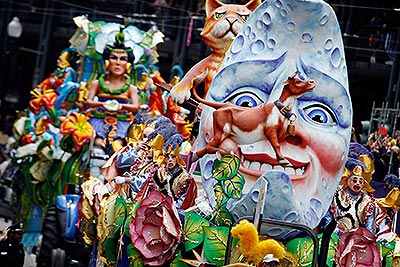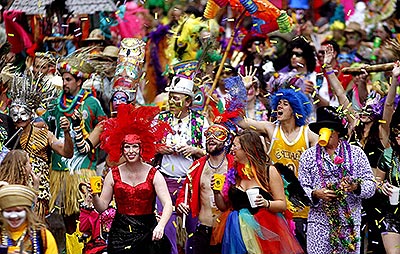The New Orleans Mardi Gras
 For its unmatched exuberance, lively spirits, and city-wide participation, the Mardi Gras celebration in New
Orleans can be regarded as the most extravagant of all American festivals. Mardi Gras is possessed by New Orleans through a bond of uniqueness, love, and tradition.
For its unmatched exuberance, lively spirits, and city-wide participation, the Mardi Gras celebration in New
Orleans can be regarded as the most extravagant of all American festivals. Mardi Gras is possessed by New Orleans through a bond of uniqueness, love, and tradition.It first came to New Orleans through French Culture in the year 1699 when the French explorers celebrated the holiday on the Mississippi River. That was pretty long ago. In 1827 some young men who came back from completing their education in Paris introduced recent French ingredients to the event. Yet that was not all. Since then Mardi Gras has many ups and downs with the popularity waxing and waning accordingly.
The past:
At first the masked revelers merely marched through the city on the day. By 1838 pageants of sorts were held. Then the festivities deteriorated. The local newspaper reports available then revealed that the Carnival had lacked the taste and spirit.The turning point came in the year 1857 when the first night parade was performed on Mardi Gras by an organization called the Mystick Krewe of Comus. It changed the picture thoroughly and gave it a permanence that has lasted to this day. Then in 1872 the Krewes of Rex was formed to provide an entertainment and spectacle for the Grand Duke Alexis of Russia who was passing through the city. This is said to have introduced various marchers and floats in the parade. Following Rex, other organizations like Momus, and Proteus were formed, and today there are more than 60 Mardi Gras organizations in New Orleans.
The present festivities:
The Mardi Gras season of galas begins about two weeks before Fat Tuesday. During those two weeks, parades can be viewed nightly and on weekends. Almost all businesses are closed for Lundi Gras (Fat Monday) and for Mardi Gras itself. Visitors from all over the world throng the city of New Orleans to enjoy this extravagant holiday.The festivities which open officially on Epiphany with the Twelfth Night (Jan 6) Reveler's Ball, come to a close with the final ball on Mardi Gras night. Both the Rex Association and the Comus Krewe have their balls late night. The dancing in the royal courtroom set up starts with the song that has become the trademark of the Mardi Gras, "If Ever I Cease to Love."
At midnight, Rex and his queen appear at the Comus Ball and the royalty toast each other. There is dancing until dawn; but elsewhere in the the city the crowds melt away earlier and the streets wear deserted look.
Parades:
 However, the parade is the main attraction of the New Orleans Mardi Gras and precedes the balls.
The entire Bourbon Street is dedicated to the parades and has a world wide
fame. Each of the organizations picks a king and a queen for its parade.
These parades comprise floats, dancers and bands. Most parades have at least 15 floats. The elaborate procession of floats, decorated to depict different themes, are pulled by tractors.
However, the parade is the main attraction of the New Orleans Mardi Gras and precedes the balls.
The entire Bourbon Street is dedicated to the parades and has a world wide
fame. Each of the organizations picks a king and a queen for its parade.
These parades comprise floats, dancers and bands. Most parades have at least 15 floats. The elaborate procession of floats, decorated to depict different themes, are pulled by tractors.The Rex parade is the highlight of the day. Saluting his queen who sits in the reviewing stand in front of the Boston Club, Rex is toasted by the mayor. Manned by his glittering, masked knights the Rex parade then slowly winds its way through the narrow streets of the Vieusx Carré. The press of people is tremendous. There are simply too many to be contained along the sidewalks. And they come spilled over the streets making the streets crowded. But no problem no one around is busy as all businesses remain closed on the day. And the festive revelry floods the whole city.
As the parade with its costumed figures on the floats crawls its way through the crowded streets, viewers along side shout with the traditional Mardi Gras cry: "Throw me something mistuh!" Strings of beads, doubloons, cups and trinkets are thrown into the air. Beads are of plastic and come in all different colors, shapes and sizes. They resemble jewels that royalty would wear. Doubloons are metal coins that are about the size of a silver dollar. They come in different colors and are stamped with the krewes' emblem and their theme for the year. Similar to doubloons, cups bear the krewes emblem and theme for the year. Trinkets might be anything from a candy, to stuffed toys, and knickknacks of every description.
They are almost worthless, but a stranger would never know it judging by the enthusiasm with which they are received and fought for.The floats, the dancers and the marching units with the innumerable bands apart, the city on Mardi Gras is thronged with ordinary citizens who for the day have become quite extraordinary. With costumes of all colors and varieties the children and the grown ups alike become circus clowns or fabulous beasts or live comic-strip characters. Some groups may also cavort according to their whim as harem beauties or Indians or famous Americans.
In the opinion of many, the real Mardi Gras resides as much in the efforts of such people as in the impressive parades.
 Friendship Day
Friendship Day Good Morning
Good Morning